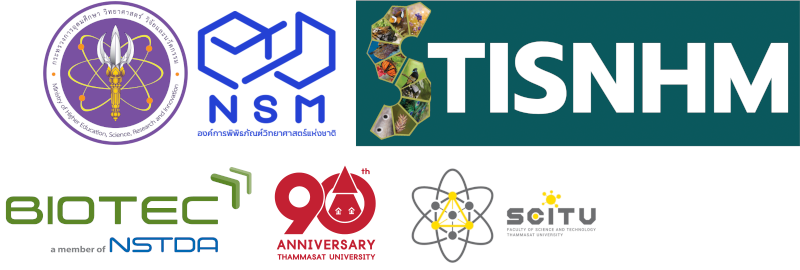Preparation of full article
Preparation of full article
About articles
Proceedings of the Symposium on The 5th Thailand International Symposium on Natural History Museums 2025 (TISNHM 2025): A Challenging Future of Global Biodiversity (visit the website:http://journal.nsm.or.th/academic-seminar)
Symposium Proceedings of the Natural History Museum started in 2020. The original articles will be compiled from the authors who gave presentation in the symposium. The proceedings have been improved continuously. Nowadays, the articles are good quality and have been more and more cited. The National Science Museum, Thailand (NSM) organizes the Thailand International Symposium on Natural History Museums and publish the proceedings yearly, so the NSM would like to invite all researchers to join the symposium and submit full articles for consideration of publication in the Symposium Proceedings of the Natural History Museum. The format of the proceedings are as follows:
Policy and scope of the publication: Symposium Proceedings is a rapidly published and peer-reviewed journal in English which publishes original papers on biodiversity, taxonomy, ecology, museum management, science communication, etc. The articles originating from presentation in the Thailand International Symposium on Natural History Museums are the priority for publication.
Consideration process: Each manuscript will be refereed by two reviewers and will be published within five months after submission.
Types of articles: Full articles, review articles and short communications.
Language: English.
Publication date: The proceedings will be published in May 2026.
Publisher: The National Science Museum, Thailand.
Submission: Manuscripts should not exceed 15 pages (A4, including figures). Submit the manuscripts to our web site via this link [] . The text should be arranged according to the following scheme:
- Title: It should be concise and consistent with the content of the article, centered on the top of the page.
- Author’s name: Use the full name without specifying gender, rank, or position.
- Author’s address: Please specify the place of work (institution) and the addresses of all authors, along with the author’s contact address, by specifying the name of the organization, place of work, district, province, postal code, and the corresponding author’s email address.
- Abstract: The abstract should summarize the essence of the work in its entirety, and not be more than 300 words in length. Please specify no more than 5 keywords at the end of the abstract.
- Introduction: Describe the importance of the problem, examination of documents related to the research only, the research objective, research scope, research conceptual framework, and research hypothesis (if any).
- Materials and methods: Write concisely about what materials were used in the research and the methods that were used. Other research articles may be referenced (if applicable).
- Results and discussion: Experiment results and discussions are written together. Only display important and necessary information. Insert images and tables in the body, suing Figure in the image references and Table in the table references.
- Summary: Be concise, elevating the significance of the research (if any).
- Acknowledgements: Should not exceed 50 words.
- References: Documents and references are to be sorted in alphabetical order and year of publication. The references in Thai must be translated into English. All literature cited in the text must be listed in the references in the following format.
Reference to article in journal:
Dawwrueng, P., S.Yu. Storozhenko and T. Artchawakom. 2016. Mimadiestra sirindhornae sp. nov. from Thailand (Orthoptera: Rhaphidophoridae: Aemodogryllinae). The Thailand Natural History Museum Journal 10(2): 253–262.
Jaitrong, W. and Y. Tohkiri. 2021. Review of the pointed ant genus Lophomyrmex (Hymenoptera: Formicidae: Formicinae) in Thailand and its role in ecosystems. Journal of Thai Forestry 40(1): 18-33. (in Thai)
Reference to book:
Cox, M.J. 1991. The Snakes of Thailand and Their Husbandry. Krieger Publishing Company, Malabar, Florida. 526 pp.
Newton, A.F., M.K. Thayer, J.S. Ashe and D.S. Chandler. 2000. Staphylinidae Latreille, 1802. In: R.H. Arnett and M.C. Thomas (eds.), American Beetles. Vol 1. Archostemata, Myxophaga, Adephaga, Polyphaga: Staphyliniformia.
CRC Press, Boca Ratin, pp. 272–418.
Reference to unpublished thesis or report:
Jaitrong, W. 2012. Taxonomy and biogeography of the ant genus Aenictus (Hymenoptera: Formicinae: Aenictinae) in Southeast Asia. PhD dissertation. Kagoshima University, Japan, 285 pp.
Reference to article on the Internet:
Antweb. 2017. Genus: Calyptomyrmex Emery, 1887. Downloaded from https://www.antweb.org/browse.do?subfamily=myrmicinae&genus=calyptomyrmex&rank=genus&project=allantwebants on 24 July 2021.
Preparing of the Manuscript
1. Page layout: Set the top margin, bottom margin, and right margin to 2.5 cm. Left margin is to be set to 3.0 cm.
2. Font: TH Sarabun, size 14.
3. Main heading: Use 18 bold and center it on the page, such as for the foreword, materials and methods, etc. If the subject is written in English, main topics use uppercase letters such as for the Abstract and References.
4. Headings for sub-topics: Use bold font and left-aligned letter, size 16, and start inserting numbering. In the next bullet, use bold font, size 14.
5. Page numbers are to be placed in the top right corner.
6. Enter line numbers (start on each new page).
7. Details in the Tables and Figures must be written in English, using the TH Sarabun PSK font, size 14 and referred to in the text.
Experts: The authors can notify their intentions to have 2 experts review their articles. They should not be affiliated with the same institutions as the authors. Suggestions can be sent via email to: Bhanumas@nsm.or.th along with the original manuscript.
Proofs: Proofs will be sent to the author and should be promptly returned to the editor. A total of 100 copies of each number of the journal will be printed

